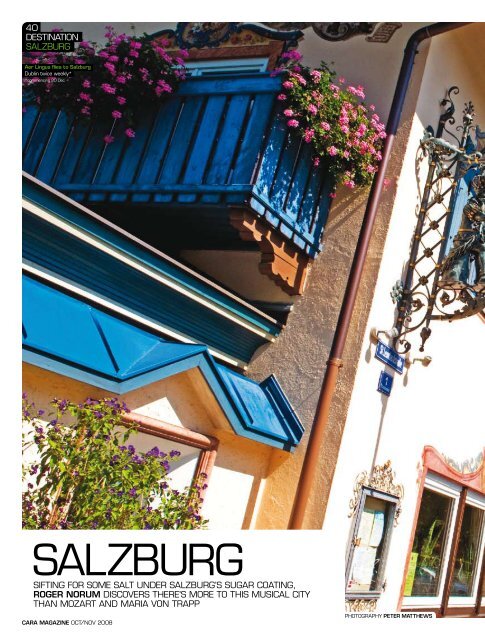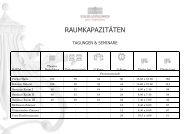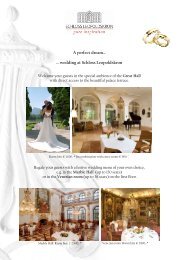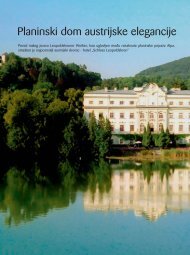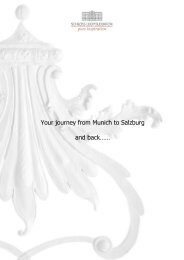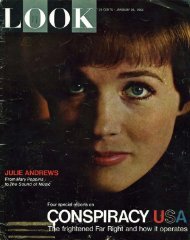salzburg - Schloss Leopoldskron
salzburg - Schloss Leopoldskron
salzburg - Schloss Leopoldskron
Create successful ePaper yourself
Turn your PDF publications into a flip-book with our unique Google optimized e-Paper software.
40<br />
destination<br />
<strong>salzburg</strong><br />
Aer Lingus flies to Salzburg<br />
dublin twice weekly*<br />
*commencing 20 dec<br />
<strong>salzburg</strong><br />
sifting for some salt under <strong>salzburg</strong>’s sugar coating,<br />
ROGER NORUM discovers there's more to this musical city<br />
than mozart and maria von trapp<br />
CARA MAGAziNE oct/nov 2008<br />
photography PETER MATTHEWS
St Leonhardt<br />
41
42<br />
destination <strong>salzburg</strong><br />
Dom cathedral, opera performers<br />
call me a yokel, but the opportunity rarely presents itself – for me, at least – to<br />
share breakfast with a Nobel Prize winner, be treated to lunch by a descendant of one<br />
of the last century’s greatest novelists, have dinner cooked by a French film star and<br />
meet for an intimate chat with a ravishing classic stage actress and one of Britain’s<br />
most esteemed playwrights.<br />
I fervidly object to name-dropping, but for the reader’s benefit, I will enumerate:<br />
Pamuk, Kafka, Depardieu, Redgrave and Hare. And to elaborate further: Orhan was<br />
staying at my hotel; Franz’s grandniece manages it; Gérard was celebrity chef-ofthe-month<br />
at a local restaurant; and Vanessa and David were giving a talk on art and<br />
politics at a city cultural festival. Even if my celeb-studded first 12 hours in Salzburg<br />
were pure coincidence, they nevertheless suggest that there is much, much more<br />
going on here than merely Mozart and Maria von Trapp.<br />
We all know the stereotypical Austrian, don’t we? A yodelling goatherd in a<br />
bonny getup of tight beige shorts, leather braces and a ruffled white shirt; when<br />
not eating apfelstrudel in a mountain pasture, he is sat at a heuriger downing an<br />
earthenware stein of potent brew and playing an alphorn. Nearby, his cheery wife<br />
is whiling away her day singing and dancing down mountainsides, her flowery,<br />
technicolour frock billowing in the Alpine breeze. ><br />
CARA MAGAziNE oct/nov 2008<br />
Festung Hohen<strong>salzburg</strong> and St Peter's Church<br />
<strong>Schloss</strong> Mirabell
Getreidegasse<br />
Salzburg’s rooftops<br />
Café-bar on Anton-Neumayrplatz<br />
Mozart’s birth home<br />
43
44<br />
destination <strong>salzburg</strong><br />
View of 1853 metre Untersburg Festung Hohen<strong>salzburg</strong><br />
LiNiNG THE CObbLESTONES ALONG GETREidEGASSE ARE<br />
UNdULATiNG STRETCHES Of UNAdORNEd STUCCO fAÇAdES iN<br />
MAUvE, bEiGE ANd LiME PASTELS THAT HOUSE EvERyTHiNG fROM<br />
fivE-STAR bOUTiqUE HOTELS TO bEdRAGGLEd gasthaus EATERiES<br />
It’s a fanciful depiction, but for years Salzburg – like Austria<br />
itself – has suffered from gross clichés, thanks in large part to the<br />
two types of tourists who have tended to visit the city: those who<br />
come for The Sound of Music and those who come for the sounds of<br />
Mozart. Both Hollywood movie and child prodigy were conceived<br />
and produced here, and today they have become the city’s cash<br />
cows nonpareils. Each summer, gaggles of singing and humming<br />
tourists are bussed in and pandered to prodigiously, with lengthy<br />
tours, kitschy souvenirs and spiels about Salzburg that bottle the<br />
city in another epoch.<br />
But as someone who has never made it through the film and<br />
who finds Mozart’s arias slightly saccharine, I’ve come here looking<br />
for something else: inspiration, wonder and a bit of, well, salt.<br />
Set among the foothills of the northern Alps, Salzburg presents<br />
an alluring collection of narrow streets and patios, landscaped<br />
gardens and parks, spectacularly opulent Baroque churches and,<br />
towering above them all, a massive rococo fortress. This grandeur<br />
notwithstanding, it’s also a decidedly small city (and, refreshingly,<br />
a very walkable one) whose diminutive proportions are vastly<br />
incongruous with the hefty imprint it has left on Europe’s cultural<br />
heritage.<br />
First settled by Celts, the “City of Salt” thrived for 2,000 years off<br />
the large saline deposits in the surrounding mountains, existing<br />
as an independent conservative monarchy ruled by affluent<br />
archbishops until the 19th century. It was these bishops – granted<br />
the rare title of “princes” under the Holy Roman Empire – whose<br />
championing of art and music provided Salzburg with much of the<br />
cultural currency it deals in today.<br />
Yet despite – or possibly because of – this rich cultured past, the<br />
city has been making recent efforts to progress beyond its reliance<br />
on such laurels, shedding its sugar coat and subtly reinventing itself<br />
as a chic and cosmopolitan Alpine city with retro cafés, avant-garde<br />
art installations and a whopping 4,000 concerts, performances and<br />
cultural events held throughout the year. Salzburg’s salt is no longer<br />
in the subterranean mines that spawned its name, it’s right here on<br />
the streets of the city itself.<br />
Salzburg is best explored from its heart and soul, the Altstadt<br />
CARA MAGAziNE oct/nov 2008<br />
St Peter cemetery<br />
Glockenspiel<br />
– a 12th-century pedestrian-only old quarter that unfolds along<br />
the south bank of the brisk Salzach river, flanked above by sheer<br />
slabs of the Mönchsberg mountain. Lining the cobblestones along<br />
Getreidegasse are undulating stretches of unadorned stucco façades<br />
in mauve, beige, rose, chalk and lime pastels that house everything<br />
from five-star boutique hotels to bedraggled gasthaus eateries. The<br />
city’s early architects managed to make Baroque and Gothic feel<br />
excitingly contemporary: the aesthetic of these interconnecting<br />
17th-century through-houses is at once gingerbread-house diorama<br />
and sophisticated, Scandinavian-styled minimalist.<br />
Yet local storefronts haven’t adopted the bland, “modern” high<br />
street style common throughout much of Europe, for Salzburg’s<br />
strict heritage preservation laws prohibit conspicuous public<br />
displays of advertising. So while, for example, the Altstadt does<br />
regrettably have a McDonald’s, the sole reminder that it exists is<br />
an ornate bladed wreath in wrought iron that hangs off its façade,<br />
a pair of tiny telltale golden arches suspended at its centre. That<br />
the restaurant is allowed to display the “M” at all is likely to stem<br />
from its sharing a first letter with another ever-popular Salzburg<br />
franchise: Mozart.<br />
As much as you may try to avoid him, these hills are very<br />
much alive with the sound of Wolfgang, and local chamber<br />
groups perform his music every single day of the year. The fact<br />
that the composer was far from the city’s biggest fan (“You<br />
have to admit yourself that in Salzburg … there isn’t a penny’s<br />
worth of stimulation”, he wrote in a letter to his father in 1781)<br />
hasn’t stopped the city from branding itself as the world’s<br />
Mozart-Stadt. Mozartmania is everywhere, at times in incarnations<br />
that test the patience of even the most steadfast Figaro fan.<br />
There’s Mozartplatz (Salzburg’s largest open square), Mozartkugel >
46<br />
destination <strong>salzburg</strong><br />
(a marzipan-nougat-pistachio chocolate), Flughafen Salzburg W A<br />
Mozart (the airport) and Amadeus (a cologne). He even has his own<br />
university, the – wait for it –Mozarteum.<br />
The house in which Mozart was born is a canary yellow stone<br />
building halfway down Getreidegasse whose creaky floorboards<br />
and kitschy fixtures narrate the composer’s short, ludicrously gifted<br />
life (he died at 35).<br />
Thread your way past the 1407-built, rococo-styled city hall tower<br />
to take in the din of olde-worlde city shops and manufactories, as<br />
furriers and bakers, confectioners and liquor makers, haberdashers<br />
and antiquitäten purveyors putter about their wares.<br />
Onwards from the Alter Markt, or old market square, where<br />
mules were once bartered for cure-alls, stretch Goldgasse and<br />
Judengasse, streets that were erstwhile home to Salzburg’s small<br />
Jewish population some 500 years ago. Salzburg’s second famous<br />
son, pharmacist-turned-poet Georg Trakl, was also born here. Trakl<br />
penned lyrical poetry that scrutinized humanity’s dark edges but,<br />
unlike Mozart, he considered Salzburg the most beautiful city in<br />
the world.<br />
CARA MAGAziNE oct/nov 2008<br />
Mirabellgarten and <strong>Schloss</strong> Mirabell<br />
These narrow curving streets open up at a triumvirate of<br />
grand open platzes. Dominating the Domplatz, Mozartplatz and<br />
Residenzplatz is the city’s baroque masterpiece cathedral, with its<br />
three massive bronze doors ornamented in enamel. The church<br />
stands just next to a tower containing a glockenspiel carillon of 35<br />
bells that ring out in choreographed song several times a day.<br />
Past a collection of ready-for-hire horse-drawn carriages stands<br />
St Peter’s, a High Romanesque flat-roofed basilica with statues,<br />
murals and bright, ornamented gilding that runs the length of its<br />
barrel-vaulted hall. Mozart composed and premiered many of his<br />
works, such as his haunting Mass in C Minor, specifically for the<br />
church’s six pipe organs. Just outside, pressed up against the rock, is<br />
one of the oldest and most atmospheric cemeteries in Europe, a stillactive<br />
cloistered garden with decorative iron crosses, centuries-old<br />
stone engravings and hermitages built right into the Mönchsberg<br />
mountain that flanks the city. Nearly all of Salzburg’s buildings were<br />
constructed with conglomerate rock quarried from the Mönchsberg,<br />
and in some places they are built to hug it so closely that they look<br />
to be chiseled right out of the mountainside itself. Still, don’t be >
48<br />
destination <strong>salzburg</strong><br />
Makartplatz<br />
MANy PARTS Of SALzbURG fEEL SURPRiSiNGLy SOUTHERN,<br />
WiTH iTALiANATE COURTyARdS, COLONNAdEd ARCHES<br />
ANd MEdiTERRANEAN SqUARES Of fOUNTAiNS ANd UNEvEN<br />
CObbLESTONES<br />
deceived by the mount’s bulk: it has since been fully hollowed out as<br />
a municipal car park. Its capacity? Five thousand vehicles.<br />
Slink your way past the city’s three adjacent monumental<br />
concert halls (all those drivers need to go somewhere after parking),<br />
elephantine chambers nestled into the mountain for acoustic<br />
effect. Opposite them stands one tenth of a decade-long municipal<br />
art project – more salt. Each year, a commissioned international<br />
artist unveils a large-scale conceptual sculpture somewhere in<br />
the city. There’s a 15-metre silver chair on the quai, a man perched<br />
on a colossal gold sphere by the cathedral, and here in the middle<br />
of an open pebbled patio, a seven metre-high self-standing stone<br />
chamber by German artist Anselm Kiefe.<br />
Just beyond, the afternoon market at Universitätsplatz offers the<br />
quintessential, warming Austrian snack for a brisk autumn day: a<br />
spicy frankfurter on a slab of rye bread doused with sweet mustard,<br />
then downed with a cold bottle of local Steigl beer.<br />
For a city with such strong Teutonic roots, many parts of Salzburg<br />
can feel surprisingly southern, with Italianate courtyards, colonnaded<br />
arcades and Mediterranean squares of fountains and uneven<br />
cobblestones. Strolling past its outdoor market stalls and along its stone<br />
passageways, the city becomes manifestly provincial. It’s a sentiment<br />
perhaps best expressed by gemütlich, a German adjective whose<br />
approximate definitions include cosy, snug, homelike, unhurried,<br />
comfortable, sociable and jovial – hardly urban sensibilities.<br />
Come late autumn, this small-town gemütlichkeit envelops<br />
the city: stone vaulted passageways are lit up with flaming<br />
torches, Advent choirs and brass ensembles perform at the central<br />
Christmas market (which begins not at Christmas but in mid-<br />
November: economy of scale) and the aroma of roasted chestnuts,<br />
spicy gingerbread and mulled wine is everywhere.<br />
After seeing the city up close, have a gander at it from up<br />
above – on a serene walk through the leafy hills that peer out over<br />
the city. On your way, fill up on a pint (or, if you prefer, a two-litre<br />
stein) of hoppy lager at the Augustiner Bräustübl, a cloister-cumbrewery<br />
placed halfway up the mountain. From here, a serpentine<br />
path shepherds you along the Mönchsberg ridge past the city’s<br />
modern art museum, teeming with vistas of cream-white edelweiss<br />
CARA MAGAziNE oct/nov 2008<br />
Mirabellgarten entrance<br />
Horse-drawn carriage<br />
and a green, auburn and mustard-coloured landscape – shades that<br />
mirror the glimmering copper and gold spires atop Salzburg’s two<br />
dozen churches.<br />
The path terminates at the Hohen<strong>salzburg</strong> Fortress, an<br />
impregnable medieval castle so enormous you feel as though you’re<br />
in another city entirely. Adorned with bastions, barbicans and<br />
turrets, it’s a clichéd image – wealthy rulers lording it over peasant<br />
subjects from a towering, cliff-side castle – but in the warm glow of<br />
twilight, it is simply breathtaking.<br />
On a recent crisp evening, I stood looking out from the castle’s<br />
Reck watchtower. Before me, a cinematic countryside sprawled<br />
south towards the horizon: perfectly mowed lawns and shorn<br />
hedges gave to manicured fields and jade hills, the rugged,<br />
powdered Alps and their deep mountain lakes resting just beyond.<br />
Here, perched high above one of Europe’s most engaging cities, it<br />
was easy to see why Austrians built their country’s cultural capital<br />
so close to Mother Nature; why Hollywood chose it to film one of<br />
the world’s most successful movies; why the world’s most talented<br />
composer produced his most memorable symphonies and operas<br />
here; and why, for that matter, everyone from curious journalists to<br />
Nobel Prize-winning novelists comes here in search of inspiration.<br />
As I took all this in, a nearby quartet of Russian balalaika and<br />
accordion street musicians launched into an uptempo version of<br />
Mozart’s Serenade in G Major. Mozart might have been rolling over<br />
at that moment, but I was heady with exhilaration. I was perched<br />
in a fairy-tale castle, a gorgeous city was coming to life below, a<br />
little night music was being strummed and a light breeze stirred in<br />
the hills around me. Mozart all of a sudden didn’t feel so schmaltzy<br />
anymore. Salzburg, I came to realise, had managed to perfect that<br />
elusive, fine line between the sweet and the savory.
50<br />
destination <strong>salzburg</strong><br />
<strong>salzburg</strong><br />
guide<br />
CARA MAGAziNE oct/nov 2008<br />
Where<br />
to stay<br />
blaue ganz<br />
this superb, 650-year-old boutique art<br />
hotel, set right on the cobbles of<br />
getreidegasse, is one of the city’s finest<br />
places to stay. the compact rooms are<br />
modern and feature translucent glass<br />
doors, recessed lighting, white leather<br />
couches and abstract art. some even have<br />
skylights and exposed oak flooring.<br />
blauegans.at<br />
hotel goldener hirsch<br />
<strong>salzburg</strong>’s premiere luxury hotel is a swish<br />
place that counts Queen elizabeth and<br />
picasso among its guests. pamper yourself<br />
in classically-furnished, riverside rooms set<br />
across four townhouses, then dine in one of<br />
two world-class restaurants – one rustic,<br />
one haute. it wasn’t named Travel+Leisure’s<br />
best hotel in austria last year for nothing.<br />
goldenerhirsch.com<br />
hotel stein<br />
set right on the water, this classy, modern<br />
hotel offers 55 boutique rooms with décor<br />
that ranges from renaissance-meets-art<br />
nouveau classical to zebra-stripe modern.<br />
many of the brightly-coloured rooms have<br />
stucco ceilings and views to the salzach.<br />
staff members are extremely helpful and<br />
the hotel’s roof terrace restaurant-bar<br />
offers great views of the city. hotelstein.at<br />
schloss fuschl<br />
set about 20 minutes from downtown<br />
<strong>salzburg</strong>, this prodigious château is one of<br />
the most resplendent and opulent places to<br />
stay in europe. built in 1450 as a royal<br />
hunting lodge, the 110 rooms and suites<br />
were fully re-imagined in 2006 with period<br />
furniture and rare artwork. the attached<br />
spa, with sauna, Jacuzzi and pool, overlooks<br />
a large private lake. schlossfuschlresort.at<br />
schloss leopoldskron<br />
a few minutes from downtown, this large<br />
rococo palace – an archbishop’s estate in<br />
the 1700s and a fixture in The Sound of<br />
Music – is set on a private lake. the 64<br />
spacious rooms and suites feature lovely,<br />
decorative stucco ceilings and modern<br />
furnishings, and its ornate great hall, with<br />
fireplace, is the perfect spot to relax.<br />
schloss-leopoldskron.com<br />
eat, drink,<br />
luxury<br />
café tomaselli<br />
in business since 1705, this is the city’s<br />
premiere viennese coffee house. mozart<br />
used to come here when he needed a<br />
pick-me-up from composer’s block, and with<br />
period inlaid wood panelling, marble tables<br />
and tuxedoed waiters, it makes the perfect<br />
late afternoon stop. they serve 40-odd<br />
homemade cakes and pastries, as well as<br />
coffee specialties. alter markt 9<br />
carpe diem finest fingerfood<br />
this concept restaurant is a sleekly-styled<br />
spot across two floors, featuring lazy<br />
couches out front and designer furniture<br />
inside. the gourmet bite-sized dishes are<br />
unique tapas-like concoctions served in<br />
small, waffle cones: mini beef burgers,<br />
risotto with chanterelles, and smoked<br />
catfish with endive salad in a dijon mustard<br />
marinade. getriedegasse 50<br />
gasthof auerhahn<br />
set across from the river salzach by the<br />
train station, chef gerhard pongratz has<br />
turned this restaurant into one of <strong>salzburg</strong>’s<br />
epicurean secrets. With outstanding table<br />
service and a delightful backyard garden,<br />
eating here is a must. try the<br />
töpfenknöedel, sweet dumplings, or the<br />
zanderfilet, a scrumptious pan-fried perch.<br />
banhofstrasse 15<br />
republic<br />
during the day, this hip café is buzzing with<br />
local students, artists and media types. by<br />
night, the neon lights come up and the dJs<br />
take over and spin everything from classic<br />
rock to drum and bass; there is occasionally<br />
live music and dancing. for more nightlife,<br />
head across the river to rudolfskai, where<br />
half a dozen bars front the salzach.<br />
anton neumayr platz 2<br />
sternbräu<br />
holding 14 massive dining rooms, three<br />
pebbled gardens, more than 10 different<br />
types of draught beer and offering seating<br />
for 1,300, you’ll forget that this 13thcentury<br />
tavern-restaurant is set right smack<br />
in the middle of town. their authentic<br />
traditional austrian dishes include spare<br />
ribs, roast pork, venison stew, meatloaf and<br />
a dozen odd fish dishes. griesgasse 23-25
sightseeing activities<br />
shopping<br />
hangar 7<br />
set alongside the airport, this architectural<br />
marvel of glass and steel is a museum<br />
showcasing a number of historic aircraft,<br />
classic cars and contemporary artwork.<br />
the attached restaurant brings in a<br />
different celebrity each month as lead chef.<br />
and don’t leave without stopping at the<br />
mayday bar, fastened to the ceiling.<br />
hangar-7.com<br />
hohen<strong>salzburg</strong> fortress<br />
this 11th-century prince’s residence is the<br />
largest completely preserved fortress in<br />
central europe. ramparts, towers, and<br />
scores of rooms and exhibits present an<br />
excellent example of life in the age of<br />
farthings and court entertainers. be sure to<br />
brave the steep, 15-minute walk up to the<br />
castle then ride the funicular down.<br />
<strong>salzburg</strong>-burgen.at<br />
mozarts geburtshaus<br />
easily the most visited destination in all of<br />
austria, mozart lived in this house until the<br />
age of 20. now a museum, it contains<br />
examples of his correspondence and sheet<br />
music, a pianoforte and clavichord – even a<br />
lock of mozart’s hair. american<br />
choreographer robert Wilson has redesigned<br />
the exhibits about mozart’s life<br />
with poetic imagery. getreidegasse 9<br />
museum de moderne<br />
not to be overlooked is this contemporary<br />
art gallery that looks out over the entire city<br />
from the mönchsberg mountain. a<br />
collection of changing photography,<br />
sculpture and abstract installation<br />
exhibitions occupy the spacious, bright halls.<br />
afterwards, enjoy a coffee or cocktail on the<br />
terrace bar of the m32 restaurant.<br />
museumdermoderne.at<br />
<strong>salzburg</strong> museum<br />
set in the new residence palace on<br />
mozartplatz, this interesting contemporary<br />
museum uses a range of media to tell about<br />
the people and political struggles that made<br />
<strong>salzburg</strong> what it is today. be sure to visit<br />
the panorama museum below, which details<br />
the archeological history of the city from<br />
roman times.<br />
smca.at<br />
grossglockner high alpine road antiquariat Johannes müeller<br />
it’s hard to fully appreciate <strong>salzburg</strong> without<br />
experiencing the amazing landscape that<br />
surrounds it. one of the best drives you can<br />
take is along the famed grossglockner<br />
hochalpenstrasse, a breathtaking route<br />
through the corinthian alps with<br />
unforgettable views of the countryside. as<br />
snow blankets the road in winter, it is only<br />
open from may until the end of october.<br />
mozart dinner concert<br />
it’s cheesy and touristy, but the singing is<br />
top notch and it’ll be a candlelit dinner you<br />
won’t forget for a while. three courses of<br />
traditional austrian cuisine are interspersed<br />
with some of the best-known arias from<br />
Figaro, Don Giovanni and The Magic Flute.<br />
held in st peter stiftskeller, the oldest<br />
restaurant in europe.<br />
mozartdinnerconcert.com<br />
<strong>salzburg</strong> marionette theatre<br />
it’s amazing what you can do with a puppet,<br />
especially when europe’s most renowned<br />
puppeteers are holding the strings. the<br />
uncanny, life-like expression of these<br />
marionettes makes their performances of<br />
operas, ballets – even a 90-minute version<br />
of The Sound of Music – beautiful, wondrous<br />
events. definitely not just for the kids.<br />
marionetten.at<br />
<strong>salzburg</strong> river cruise<br />
With all the time you’ll spend wandering<br />
through the old town, it’s possible to forget<br />
that <strong>salzburg</strong> is split into two by the<br />
quick-flowing salzach river. these guided<br />
boat trips leave from the centre of town and<br />
ply the river to the hellbrunn palace, with<br />
an opportunity to visit the <strong>salzburg</strong> zoo. a<br />
perfect afternoon trip if it’s sunny out.<br />
<strong>salzburg</strong>schifffahrt.at<br />
Sound of Music tour<br />
if you’re a fan of the film, then there’s no<br />
better way to spend a morning or afternoon<br />
than touring around on a coach with other<br />
aficionados visiting its most popular sights.<br />
the tours begin in the city, then head out to<br />
the salzkammergut countryside, covering<br />
liesls gazebo, mirabell gardens, nonnberg<br />
abbey and maria’s hills.<br />
panoramatours.com<br />
this small shop sells old, first-edition books,<br />
maps, and a number of nostalgic postcards<br />
of austria and <strong>salzburg</strong>. out front, they<br />
display a large selection of colour and<br />
black-and-white lithographs of historical<br />
figures, cityscapes, bucolic alpine scenes<br />
and mozart-looking figures playing the violin.<br />
many are under €15, and they make a<br />
unique take-me-home. haydnstrasse 5/1<br />
eduard höllrigl<br />
opened in 1594, this is the oldest<br />
bookstore in austria. centrally located, it’s<br />
also one of the largest, and your best bet<br />
for picking up picture books of the city, local<br />
cookbooks and german and austrian<br />
literature in english translation. they carry a<br />
number of versions of the works of georg<br />
trakl as well as biographies of mozart.<br />
sigmund-haffner-gasse 10<br />
katholnigg house of music<br />
set within a huge vaulted room, this shop<br />
has been selling music since 1847. it is the<br />
city’s best place to pick up cds of The<br />
Marriage of Figaro or dvds of the Marriage<br />
of Trapp. While classical is definitely the<br />
focus here, there’s also jazz, chanson and<br />
folk music. you can listen to most of the<br />
cds before buying.<br />
sigmund-haffner-gasse 16<br />
kirchtag umbrella shop & manufactory<br />
come back home from <strong>salzburg</strong> with<br />
someone no one else will have: a one-of-akind<br />
handmade umbrella. they sell their own<br />
designs, but if you have a few days, you can<br />
order a custom-made parasol of your own<br />
to match a patterned tie, wedding floral<br />
arrangement or your favourite bit of<br />
wallpaper.<br />
getreidegasse 22<br />
lanz folk fashions<br />
longing for that pair of lederhosen? this<br />
family-owned shop has been supplying<br />
generations of <strong>salzburg</strong>ers with top-notch,<br />
hand-woven “folkwear” – lacey blouses,<br />
dirndl dresses, bauernleinen jackets and<br />
waistcoats. pick up a vestment here and<br />
you might well up and abandon city for<br />
country the moment you walk out the door.<br />
schwarzstrasse 4<br />
51


